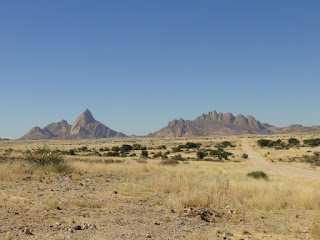Over the last week, travel from Swakopmund has been through desert and largely on gravel roads. The major stops we’ve made have been to visit the Cape Cross Seal Colony, Spitzkoppe mountain, Etosha National Park, and the Grashoek village of the San Bushmen people. At times we’ve felt like we were melting with temperatures up to 95 degrees Fahrenheit, but as we continue north we are heading into the rainy season and colossal thunder storms have been greeting us in the afternoon.
The Cape Cross seal colony just north of Swakopmund, Namibia is home to 80-100,000 Cape fur seals. We were fortunate to visit during the time of year when many pups are born – prime time for males to be defending their territory and harem. The pups were adorable, making ridiculous lost-lamb bleating noises and trying to scoot about on the sand. The enormous males, about 3 times the size of females, clumsily bulldoze over anything or anyone in their path while they bark and defend their beachfront property.
LOTS of Cape Fur seals at Cape Cross, Namibia.
Mama seal and pup.
Spitzkoppe and its neighboring mountains rise out of the desert 700 meters without any surrounding foothills for a total height of about 1700 meters.. Yellow in appearance they are a granite made of much more quartz and feldspar than mica, but very grippy under the soles of your shoes and fun to scramble up. We spent 5 hours one morning climbing nearly to the top of one monolith with two friends before finding the route impassable and the day too hot to find another way. The succulent plants, trees and cactuses that we passed on our climb continue to remind us of Dr. Seuss illustrations.
Spitzkoppe and surrounding mountains.
Rich hugging a cactus.
Carissa's favorite Dr. Seuss tree.
Etosha National Park is a 22,000 acre reserve for wildlife in the north-central portion of Namibia. It is centered around a 60 km-diameter salt flat (the Etosha Pan) that was dry for us, but in the rainy season is a briny lake that attracts thousands of flamingoes. The surrounding bush is savannah and scrubland. We stayed in two separate campsites that were quite luxurious by our American-National Park standards as they are marketed as wildlife resorts. Swimming pools helped us cool down after the log days and flood-lights on the adjacent water-holes allowed us to see the visiting nighttime beasts. Black rhino, some elephants and giraffe were the most frequent visitors we saw at the water-holes. Lions lurked in the darkness making eerie calls – a strange sound to be awakened to in the middle of the night.
Elephants and a rhino in the flood-light waterhole - Etosha NP.

Floodlit rhinos.
During the daytime, while touring in the Interpidmobile, we saw tons of antelope species and were lucky to see three huge prides of lions. Two of these groups were feeding while we watched—one on a rhino and the other on a zebra. The cubs playing around their parents were of course lots of fun to watch.

Sunrise at our campsite in Etosha National Park.
Female lion and cubs on a rhino kill.

From left to right: springbok, oryx, zebra, wildebeest, oryx.

Old-man Kudu.
Pumba (warthog) in a water hole.

Oryx
Lions near a zebra kill.

Approaching storm in Etosha.
San bushmen in traditional dress demonstrating how to make fire.
At night we watched traditional dance performance. Singing and clapping maintain the rhythm as a healer demonstrated how through dance many ailments would be “brought out” of individuals. In the background was the audible din of a generator running about 250 yards behind the performers to power the only lights in the village – one red, one white, and one blue – at the village bar. An interesting juxtaposition of old and new. It was nice to meet some of the people of this community, but still strange to visit people for tourism purposes. Playing with the kids that came to watch us put up our tents helped a lot, though. Carissa became a jungle gym for as many as four different little ones at a time and some young boys played keep-away from Rich with a soccer ball and some others of our group.















No comments:
Post a Comment